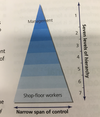Human Resource Management within a Business environment Flashcards
(73 cards)
Define Human Resource Management Objectives.
Involves the setting of objectives in the same way that other functional areas of the business require them
How should Human Resource Objectives be set?
Need to be set in alignment with other business objectives
What can unclear human resource objectives lead to…
Creates problems like… ⁃ Lack of employees with the right skill set, lead to use of agency staff ⁃ Lead to reputation problems as cash flow problems ⁃ Could lead to legal issues if objectives are not set in alignment with legislation
Why a business needs to set clear Human Resource Objectives?
Enables overall objectives of the business to be achieved and for change to be successfully implemented
What is the importance of a human resource strategy to meet the needs of a business?
⁃ Ensuring the right number of staff are employed is vital to avoid a high staff turnover as well as meeting consumer needs ⁃ Appropriate skill level and number of employees means that the business can work efficiently which will positively effect stakeholders
Factors that affect Human Resources objectives.
⁃ Changing needs of the business - change in sales trends means business may produce more of one product and will therefore need more of a certain skill set ⁃ When staff leave they have to be replaced ⁃ Increased sales may mean there is greater need for staff overall
Evaluate the importance of human resource management objectives in the achievement of a business’s objectives.
⁃ is there sufficient number of workers available ⁃ Is there sufficient number of workers with the right SKILLS ⁃ Location of the business, if it is an unattractive location workers will not want to move to work ⁃ Government legislation, this may make it harder or more expensive to take on workers
Explain what is meant by an Organisational Chart.
Diagram shows the hierarchy of a business, usually from top to bottom
Explain what is meant by Span of Control.
Is the number of employees for whom a manager is responsible for.
What is a Wide Span of Control?
A Wide Span of Control means that the manager is responsible for many employees
Explain what is meant by an Organisational Structure.
The way in which a business is organised
Problems of a WIDE Span of Control.
⁃ Number of channels of communication increases and therefore effective communication may break down
Problems of a NARROW Span of Control.
There are more layers for communication to pass through so communication can be affected
Explain what is meant by Chain of Command.
The way in which responsibility for employees is organised within a business
Why is Chain of Command useful?
Is a useful guide to the lines of communication in an Organisation
Explain what is meant by Levels of Hierarchy.
Refers to the number of levels in a business organisation
A (……) organisational structure will have fewer levels than a (……) organisational structure.
Flat Tall
What does delayering do to the costs of the business?
It reduces costs
What are the benefits of Delayering?
⁃ Allows more responsibility and therefore increases motivation ⁃ Decision making process is quicker
Define Delayering.
Reducing the number of levels in the hierarchy of an organisation
Disadvantages of Delayering.
⁃ Span of Control in the business will increase ⁃ Short term costs because of redundancies ⁃ Demotivate employees because they will be scared about loosing their jobs
Explain what is meant by Delegation.
is the assignment of any authority to another person to carry out specific activities.
The more delegation the (………) the span of control and the (……..) wider the organisational structure.
Bigger Wider
Explain what is meant by Empowerment.
Means giving employees responsibility for the tasks they perform




